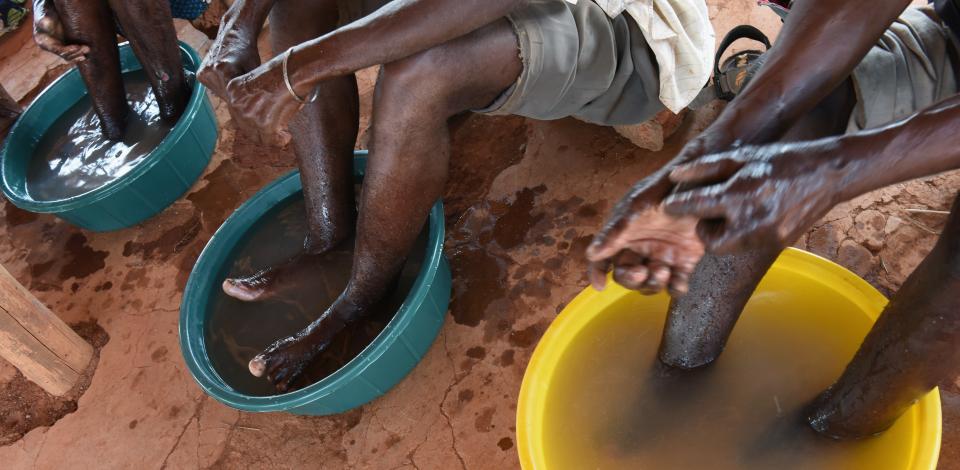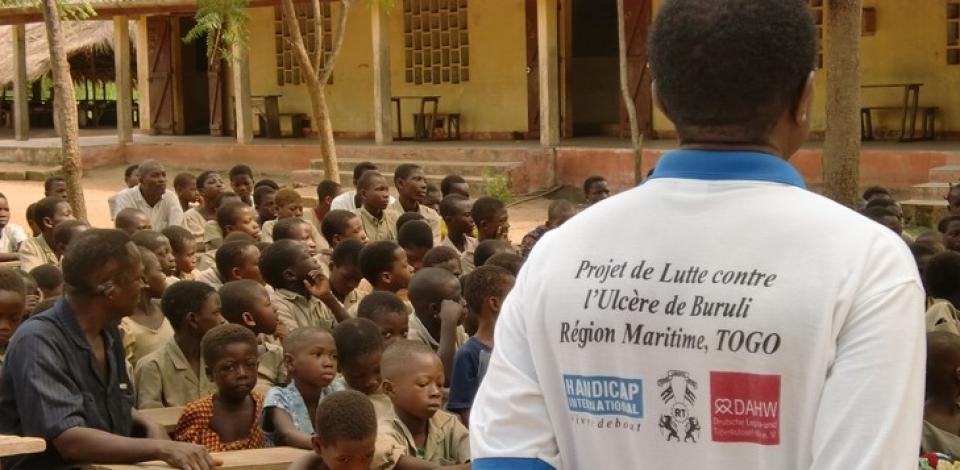
Peer and group support
At diagnosis and during treatment, it is unlikely that the health worker will have the capacity or time to talk through all the potential psychological, social and economic implications of the condition. Nor will the patient be ready to engage with all of these at once. Diagnosis with a health condition is distressing for anyone, and the natural response is to seek support from close family and friends. However, engaging with family members is not always effective or possible. Family members may refuse to have anything to do with the person affected, they may be willing to help but feel overwhelmed by it or they may be unavailable – for example if the patient is a migrant labourer who is far from home.
The social rejection experienced as a result of stigma and discrimination can be devastating. Separation from home, spouse or children and loss of livelihood can leave someone not only alone, uncared for and destitute, but also feeling that they no longer have a purpose. Fear of such rejection by loved ones, and the consequent separation, can lead some people to try and hide their health condition. This makes people feel that they must face it alone, with the additional burden of carrying such a secret and the fear of discovery. Facing such a burden alone can be distressing, and the impact on mental wellbeing can easily lead to destructive behaviour ranging from poor treatment compliance and unexplained irritability with loved ones to self-harm and even attempted suicide.
Even where health or welfare interventions may address some of the immediate needs of a patient, they cannot replace the value of feeling wanted or needed, which typically comes from family or colleagues. In these scenarios, it is vital that people affected by NTDs understand that they are not alone. Newly diagnosed patients, and those who have had the disease for many years but may still be coming to terms with complications from it, will urgently need direct and personal support from others with similar lived experiences, especially if they are feeling rejected and stigmatised by their own family or community. It is vital that they be able to access this support when they need it, where they need it (i.e., without having to travel far to an urban health facility), and for as long as they need it.
Peer support between people affected has a reciprocal effect. The person being helped benefits from the empathy, experience and advice of someone who has faced similar issues and knows what they are now going through. The person helping also benefits, because they now have a new sense of purpose, and the knowledge that other people need their help can be a strong motivator and confidence booster.
Case study: ‘Mental Motivators’, Bangladesh
In Bangladesh, mental health services are not easily available for rural, poor people. This particularly affects those affected by leprosy and lymphatic filariasis (LF), who are prone to developing anxiety or depression.
The charity Lepra had already set up groups to promote physical self-care and to improve people’s economic resilience and access to services. Lepra began to select ‘Mental Motivators’ from the groups – people who showed interest and good communication skills – and to train them in basic mental health care. The training covered basic counselling skills, the assessment of mental distress, the management of depression and anxiety, reporting and referring. A specific toolkit was developed for the Mental Motivators and they were also equipped with a mobile phone.
Mental Motivators offer counselling to people with a disability induced by leprosy or LF who have indicated they would like someone to talk to. Motivators also proactively look out for group members who seem to be struggling more than others and who might seem withdrawn or unhappy. Counselling takes place either on the phone or face-to-face. People were found to be anxious about their health, families, children’s future, their future, social discrimination, their job etc.
Group counselling during the self-care group meetings has also been effective. Members are encouraged to share their feelings and the priority is to listen to them and to provide information on mental health. If a person needs more highly skilled help beyond what the peer-to-peer format can offer, the Mental Motivator refers them to a Lepra or government health worker for professional help.
Awareness meetings in the community are also led by Mental Motivators. They describe the importance of mental health and provide information on how to get support from community members and Mental Motivators.

Self-help and self-care groups
For some NTDs, treatment can be complex and cannot, on its own, guarantee complete protection from physical complications and disability. In these settings, self-care groups are an established approach to providing the training, materials, encouragement and supervision required to ensure that people are practising regular and effective self-care for their impairments. Self-care groups are increasingly being used as a vehicle for other actions too. Examples are:
- Economic: group members participate in savings/credit and livelihood activities (often referred to as self-help groups).
- Advocacy: group members are educated about their rights and how to stand up for them.
- Mental wellbeing: group members are encouraged to listen to each other and provide mutual support through peer counselling.
- Physical: group members learn to properly care for their affected body parts through hands-on activities (only relevant for some NTDs).
It can be effective to integrate self-care groups for a range of stigmatising NTDs. Such integration can boost solidarity and reduce stigma against individual diseases.
Guide 2 Annex 6: Creating an effective self-help or self-care support group provides details on creating an effective self-help or self-care support group.

People’s organisations
Where self-care groups or self-help groups are not available or practical, people affected by NTDs may still need advice and support for overcoming stigma. People’s Organisations (which may operate at state, national or international level) and disease-specific civil society organisations, typically operating at community or district level, can be valuable, and the two can work well together.
Case study from the Vimukti Leprosy Colony, Kakinada, East Godavari District, Andhra Pradesh
The 100 families residing in the Vimukti Leprosy Colony were facing attempts by a local politician to seize two acres from their colony, which, though once isolated, is now prime suburban land. The colony already had its own civil society organisation, developed in partnership with the NGOs Brighter Futures and The Leprosy Mission, which had been trained by two local lawyers about human rights. Faced with this land-grabbing from the elected representatives who were supposed to serve them, the colony needed more help and called on the state-level Society for Leprosy Affected Persons (SLAP), who brought leaders and other members to their aid. SLAP and civil society organisation members protested on the streets and blocked the vehicles of the Legislative Assembly, which attracted local media attention. SLAP leaders spoke forcefully on local television news and the lawyers helped to submit a case to the Human Rights Commission in Hyderabad. The Legislative Assembly backed down and the community retained their land.
Many individuals within the colony reported pride and greater self-confidence as a result of this experience. They know their rights and they know that others will help them fight for them when needed. One lady in another leprosy colony in Raebareilly in Uttar Pradesh, who had been blinded by leprosy, reported that she had not left her house for two years, but her neighbours had been attending civil society organisation meetings and they helped her to go too. For her, the very fact of being helped to attend a meeting and sit in a room with others discussing their needs was of much greater significance than the official goals of that meeting. When people affected by NTDs are mobilised to work together for specific tangible goals, numerous other benefits spring from the mutual support such activities involve.
Online support and social media
People in areas that have few people with the disease and/or that are very remote may struggle to meet in person with other people affected by NTDs, or to join them in self-care, self-help or advocacy-related groups or activities. For some people, the stigma perceived or experienced is so strong that they fear being seen or associated with other people affected by NTDs. However, with the ever-growing penetration of mobile phones, smartphones and affordable data packages, it is increasingly possible for people affected by NTDs to communicate with, and support each other, remotely using chat groups such as WhatsApp for mutual support.
